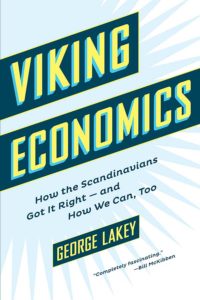Viking Economics: How the Scandinavians Got It Right—and How We Can, Too
Reviewed by Pamela Haines
November 1, 2016
 By George Lakey. Melville House, 2016. 304 pages. $26.99/hardcover; $15.99/eBook.
By George Lakey. Melville House, 2016. 304 pages. $26.99/hardcover; $15.99/eBook.
Buy from QuakerBooks
If the title of this book conjures up an image of a dense tome on the economic life of tenth-century Vikings, don’t be put off. George Lakey’s focus is all on the subtitle: How the Scandinavians Got It Right—and How We Can, Too. If one needs further enticement to enter into the unfamiliar territory of economics, consider the author’s decades of experience in social change and nonviolence training, as well as his personal history with Norway—starting with dating his Norwegian wife-to-be when he was just 20. All these threads are woven into this lively and provocative investigation of the Nordic system and what we might learn from it.
While the book tilts toward Norway, stories and examples from Denmark, Sweden, and Iceland are included as well. Lakey opens with the present, telling the story of how the Scandinavian countries experienced the international banking and financial crises of the last decade or two. What created the conditions that allowed them to rein in their banking system so robustly, and keep attention to the common good so central?
We learn of the dynamic interplay in Norway among labor, students, and small farmers over the course of three decades in the early twentieth century. Including 103 strikes in 1935 alone, the process culminated in a decisive shift in power from the traditional ruling class to the Labour Party, and to the policies that created the equality and strong safety net that Scandinavia is now known for.
Our assumptions about “normalcy” are repeatedly challenged by looking through this lens. Current U.S. economic ideology sees the higher taxes and greater regulation that come with more comprehensive government services as a drag on a dynamic economy. So how does it happen that Norway has start-up creation rates among the highest in the world and more entrepreneurs per capita than the United States? Why are they so ready to risk starting their own businesses? We are reminded that they don’t have to worry about paying for education, retirement, or medical expenses.
We pride ourselves on our productivity, yet Norwegians do better. Why? Since our model is embedded in a context of high unemployment and a weak safety net, our unions sometimes defend inefficient labor practices and outmoded organization of work in order to keep workers in jobs: insecurity creates an incentive to resist efficiency. In countries with high inequality such as ours, young people are likely to seek security in professional jobs (and fantasize about stardom). Is there an alternative? Greater equality, it turns out, creates pathways to achieving a variety of satisfying life choices, including high-wage working-class jobs.
The chapter on immigration and racial diversity raises thought-provoking questions that all of us can ponder. How can a small and homogeneous country welcome immigrants without threatening their own precious language and culture? Young people in Norway are now more interested in traditional dances and music; is this a way of rooting themselves more securely in their own ethnicity as they interact with other cultures? How can one join an assertive respect for cultural differences with insistence on laws like those that, for instance, require schooling for girls?
In one way, Viking Economics is an easy read. We travel with Lakey as he visits with relatives, takes in their questions about the United States, converses with a wide variety of people who can illuminate different aspects of the Nordic system, and wonders about what he is learning. Yet there’s nothing lightweight here. He has clearly done his homework, with lots of research data to backup any point that might be called into question. More important, his goal is enormously ambitious. He is asking us not just to enjoy a tour of a restful economy, but to wrestle with the possibility that things could be different at home.
The final chapter is organized as a response to a series of questions challenging the relevance of the Nordic model to the United States. Here Lakey’s depth as a nonviolent strategist shines through, and we are required to think hard about the limits of our assumptions around power and the potential for transformation. He is asking us to give up our resignation to evils that seem immovable, and actively imagine a new thing. Could we as a country really change course and set our sights on an economy that engenders equality and is centered on the common good? He thinks so, and I’m inclined to follow his lead.



Comments on Friendsjournal.org may be used in the Forum of the print magazine and may be edited for length and clarity.